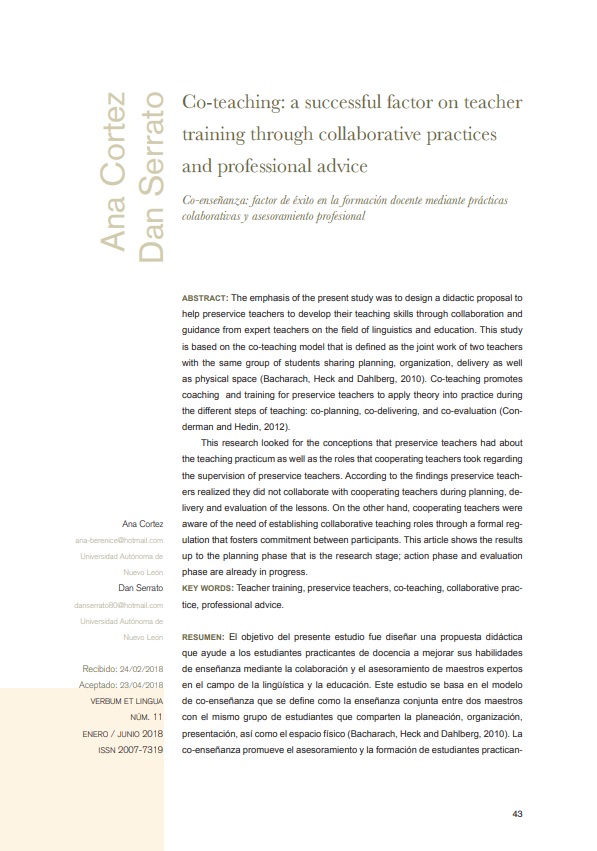Co-enseñanza: factor de éxito en la formación docente mediante prácticas colaborativas y asesoramiento profesional
DOI:
https://doi.org/10.32870/vel.vi11.102Keywords:
Teacher training, preservice teachers,, co-teaching, collaborative practice, professional adviceAbstract
The emphasis of the present study was to design a didactic proposal to help preservice teachers to develop their teaching skills through collaboration and guidance from expert teachers on the field of linguistics and education. This study is based on the co-teaching model that is defined as the joint work of two teachers with the same group of students sharing planning, organization, delivery as well as physical space (Bacharach, Heck and Dahlberg, 2010). Co-teaching promotes coaching and training for preservice teachers to apply theory into practice during the different steps of teaching: co-planning, co-delivering, and co-evaluation (Conderman and Hedin, 2012).
This research looked for the conceptions that preservice teachers had about the teaching practicum as well as the roles that cooperating teachers took regarding the supervision of preservice teachers. According to the findings preservice teachers realized they did not collaborate with cooperating teachers during planning, delivery and evaluation of the lessons. On the other hand, cooperating teachers were aware of the need of establishing collaborative teaching roles through a formal regulation that fosters commitment between participants. This article shows the results up to the planning phase that is the research stage; action phase and evaluation phase are already in progress.
Downloads
Metrics
References
Bacharach, N. Heck, T. and Dahlberg, K. (2010). Changing the Face of Student Teaching through Coteaching. Action in Teacher Education, 32(2), 3-14.
Bacharach, N. and Heck, T. (2010). Mentoring Teacher Candidates through Co-Teaching. St. Cloud, Minnesota: Teacher Quality Enhancement Center.
Bacharach, N. Heck, T. and Dahlberg, K. (2008). Co-Teaching in Higher Education. Journal of College Teaching and Learning, 5(3), 10-16. Retrieved from https://www.stcloudstate.edu/soe/coteaching/_files/documents/Co-Teaching_in_Higher_Education.pdf
Beamish, W. Bryer, F. and Davies, M. (2006). Teacher reflections on co-teaching a unit of work. International Journal of Whole Schooling, 2(2), 3-18.
Chanmugam, A. and Gerlach, B. (2013). A Co-teaching Model for Developing Future Educators’ Teaching Effectiveness. International Journal of Teaching and Learning in Higher Education, 25(1), 110-117.
Conderman, G. and Hedin, L. (2012). Purposeful assessment practices for co-teachers. Teaching Exceptional Children, 44(4), 19-27. Retrieved from https:// eric.ed.gov/?id=EJ977315
Cook, L. (2004). Co-teaching: principles, practices, and pragmatics. Retrieved from http://files.eric.ed.gov/fulltext/ED486454
Correa, E. (2011). La práctica docente: una oportunidad de desarrollo profesional. Perspectiva educacional, 50(2), 77-95.
Cramer, E., Nevin, A., Thousand, J., and Liston, A. (2010). Co-teaching in urban secondary school. Districts to meet the needs of all teachers and learners: implications for teacher education reform. International Journal of Whole Schooling, 6(2), 59-76.
Gómez, D. and Roquet, J. (2012). Metodología de la investigación. México: Red Tercer Milenio. Recuperado de http://www. aliatuniversidades.com. mx/bibliotecasdigitales/pdf/axiologicas/Metodologia_de_la_investigacion.pdf
Graziano, K. and Navarrete, L. (2012). Co-teaching in a Teacher Education Classroom: collaboration, compromise,
and Creativity. Issues in Teacher Education, 21(2), 109-126.
Hamilton, J. (2010). Cooperating teachers: an investigation into their needs and training as mentors and supervisors of student teachers (Doctoral Dissertation). University of San Francisco. San Francisco, California.
Hartnett, J., Weed, R., McCoy, A., Theiss, D. and Nickens, N. (2013). Co-teaching: A New Partnership during Student Teaching. SRATE Journal, 23(1), 5-12.
Kiggundu, E. and Nayimuli, S. (2009). Teaching practice: a make or break phase for student teachers. South African Journal of Education, 29, 345-358.
Latorre, A. (2015). La investigación-acción: Conocer y cambiar la práctica educativa. México: Editorial Gran Colofón.
Ngoepe, M. (2014). Examining Student Teachers’ Perceptions on Mentoring During Field Experiences in Distance
Learning: A Pilot Study. Journal of Social Sciences. 40(1), 41-49.
Preservice teaching. (2016). In Virginia Wesleyan College. Retrieved from http://www.vwc.edu/academics/majors/education/field-experiences/preservice-teaching.php63
Richards, J. and Farrell, T. (2005). Professional Development for Language Teachers. USA: Cambridge University Press.
Sánchez, G. (2016). Relación teoría-práctica entre el campo de la formación inicial y el escenario del ejercicio profesional. Revista Electrónica Educare, 20(2), 1-25.
Sorensen, P. (2014). Collaboration, dialogue and expansive learning: The use of aired and multiple placements in the school practicum. Teaching and Teacher Education, 44, 128-137.













